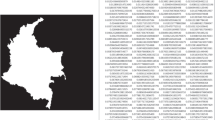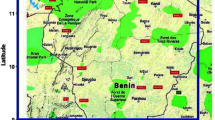Abstract
The lightning climatology over Nepal is analysed in detail for the first time. For the analysis, we utilised the satellite-based lightning imaging sensor data for the period from 1998 to 2013. A comparison of these climatological results is also performed with two ground-based lightning detection networks, namely, the World Wide Lightning Location Network and the Global Lightning Network for 3 yr from 2011 to 2013. On analysing the data obtained from the three sources, we conclude that the months of April and May are extremely vulnerable in the perspective of lightning hazards in Nepal, in contrast to the results reported previously which indicated that the maximum lightning activity occurred in the month of June. The central and eastern regions of the country receive the majority of lightning strikes during the months of April and May. The present finding is supported by the thunderstorm frequency data obtained from the disaster Information Management System, Nepal and also from thunder-day data from NOAA.











Similar content being viewed by others
References
Agnihotri G and Dimri A P 2015 Vertical structure of atmosphere in pre-monsoon season over Bangalore; J. Earth Syst. Sci. 124 1563–1572.
Baral K N and Mackerras D 1992 The cloud flash-to-ground flash ratio and other lightning occurrence characteristics in Kathmandu thunderstorms; J. Geophys. Res. 97 931–938.
Barros A P and Lang T J 2003 Exploring spatial modes of variability of terrain–atmosphere interactions in the Himalayas during monsoon onset; Hydro Sciences Report Series, 03-001, Division of Engineering and Applied Sciences, Harvard University, 51p.
Barros A P, Joshi M, Putkonen J and Burbank D W 2000 A study of the 1999 monsoon rainfall in a mountainous region in central Nepal using TRMM products and rain gauge observations; Geophys. Res. Lett. 27 3683–3686.
Barros A P, Kim G, Williams E and Nesbitt S W 2004 Probing orographic controls in the Himalayas during the monsoon using satellite imagery; Nat. Hazards 4 29–51.
Boeck W L, Mach D, Goodman S J and Christian H J Jr 1999 Optical observations of lightning in Northern India, Himalayan mountain countries and Tibet; In: 11th International conference on atmospheric electricity, NASA Conf. Publication, NASA/CP-1999-209261, pp. 420–423.
Boccippio D J, Koshak W J and Blakeslee R J 2002 Performance assessment of the optical transient detector and lightning imaging sensor. Part I: Predicted diurnal variability; J. Atmos. Ocean. Technol. 19 1318–1332.
Bluestein H B 1993 Observations and theory of weather systems; vol. 2, Synoptic-dynamic meteorology in mid-latitudes, Oxford University Press, 282p.
Carlson T, Benjamin S, Forbes G and Li Y F 1983 Elevated mixed layers in the regional severe storm environment; conceptual model and case studies; Mon. Weather Rev. 111 1453–1474.
Christian H J and Goodman S J 1987 Optical observations of lightning from a high altitude airplane; J. Atmos. Ocean. Technol. 4 701–711.
Christian H J et al. 1999 The lightning imaging sensor; In: NASA Conference Publication, NASA, pp. 746–749.
Christian H J, Blakeslee R J, Boccippio D J, Boeck W L, Buechler D E, Driscoll K T, Goodman S J, Hall J M, Koshak W J, Mach D M and Stewart M F 2003 Global frequency and distribution of lightning as observed from space by the optical transient detector; J. Geophys. Res. 108 ACL 4-1–ACL 4-15.
Cecil D J, Buechler D E and Blakeslee R J 2014 Gridded lightning climatology from TRMM-LIS and OTD: Dataset description; Atmos. Res. 135–136 404–414.
Das S K, Golhait R B and Uma K N 2017 Clouds vertical properties over the northern hemisphere monsoon regions from Cloudsat-CALIPSO measurements; Atmos. Res., http://dx.doi.org/10.1016/j.atmosres.2016.08.011.
Dowden R L, Brundell J B and Rodger C J 2002 VLF lightning location by time of group arrival (TOGA) at multiple sites; J. Atmos. Sol-Terr. Phys. 64(7) 817–830.
Fan J, et al. 2009 Dominant role by vertical wind shear in regulating aerosol effects on deep convective clouds; J. Geophys. Res. 114 D22206, http://dx.doi.org/10.1029/2009JD012352.
Goswami B B, Mukhopadhyay P, Mahanta R and Goswami B N 2010 Multiscale interaction with topography and extreme rainfall events in the North-East Indian region; J. Geophys. Res., https://doi.org/10.1029/2009jd012275.
Guha A, Banik T, De B K, Roy R and Choudhury A 2016 The effect of El Nino and La Nina on lightning activity: Its relation with meteorological and cloud microphysical parameters; Nat. Hazards 85 403–424.
He H, McGinnis J W, Song Z and Yanai M 1987 Onset of the Asian monsoon in 1979 and the effect of the Tibetan Plateau; Mon. Weather Rev. 115 1966–1995.
Hutchins M L, Holzworth R H, Virts K S, Wallace J M and Heckman S 2013 Radiated VLF energy differences of land and oceanic lightning; Geophys. Res. Lett. 40 2390–2394, https://doi.org/10.1002/grl.50406.
IPCC, Intergovernmental Panel on Climate Change 2007 The physical science basis; Cambridge University Press, New York, pp. 131–216.
Jayaratne E R and Kuleshov Y 2006 The relationship between lightning activity and surface wet bulb temperature and its variation with latitude in Australia; Meteorol. Atmos. Phys. 91 17–24. https://doi.org/10.1007/s00703-004-0100-0.
Kistler R E, et al. 2001 The NCEP-NCAR50-yr reanalysis: Monthly means CD-ROM and documentation; Bull. Am. Meteorol. Soc. 82 247–268.
Krishnamurti T N and Kishtawal C M 2000 A pronounced continental-scale diurnal mode of the Asian summer monsoon; Mon. Weather Rev. 128 462–473.
Kayastha S P and Regmi S K 2008 Nor’westers and tornadoes over the SAARC region and their forecasting and preparedness; In: Proceedings of the South Asian Association for Regional Cooperation (SAARC) Seminar, 20–21 August 2008, Dhaka, Bangladesh, pp. 28–34.
Khain A P 2009 Notes on state-of-the-art investigations of aerosol effects on precipitation: A critical review; Env. Res. Lett. 4 015004, http://dx.doi.org/10.1088/1748-9326/4/1/015004.
Kumar P R and Kamra A K 2012 The spatiotemporal variability of lightning activity in the Himalayan foothills; J. Geophys. Res. 117, https://doi.org/10.1029/2012jd018246.
Lang T J and Barros A P 2002 An investigation of the onset of the 1999 and 2000 monsoons in central Nepal; Mon. Weather. Rev. 130 1299–1316.
Lee S S, Donner L J, Phillips V T J and Ming Y 2008 The dependence of aerosol effects on clouds and precipitation on cloud-system organization, shear and stability; J. Geophys. Res. 113 D16202. http://dx.doi.org/10.1029/2007JD009224.
Lee S S, Donner L J and Penner J E 2010 Thunderstorm and stratocumulus: How does their contrasting morphology affect their interactions with aerosols? Atmos. Chem. Phys. 10 6819–6837, http://dx.doi.org/10.5194/acp-10-6819-2010.
MacGorman D R and Rust W D 1998 The electrical nature of storms; Oxford Univ. Press, New York, NY.
Mace G G, Marchand R, Zhang Q and Stephens G 2007 Global hydrometeor occurrence as observed by CloudSat: Initial observations from summer 2006; Geophys. Res. Lett. 34 L09808, http://dx.doi.org/10.1029/2006GL029017.
Makela A, Sherstha R and Karki R 2014 Thunderstorm characteristics in Nepal during the pre-monsoon season 2012; Atmos. Res. 137 91–99.
Malla G 2008 Climate change and its impact on Nepalese agriculture; J. Agric. Env. 9.
Mansell E R, MacGorman D R, Ziegler C L, Straka J M 2005 Charge structure and lightning sensitivity in a simulated multicell thunderstorm; J. Geophys. Res. 110, https://doi.org/10.1029/2004JD005287.
Pawar V, Pawar S D, Beig G and Sahu S K 2012 Effect of lightning activity on surface NOx and O3 over a tropical station during pre-monsoon and monsoon seasons; J. Geophys. Res. 117 D05310, http://dx.doi.org/10.1029/2011JD016930.
Pawar S D, Gopalakrishnan V and Murugavel P 2015 Role of orography in inducing high lightning flash rate at the foothills of Himalaya; Earth Planets Space 67 51, https://doi.org/10.1186/s40623-015-0221-3.
Pessi A T and Businger S 2009 The impact of lightning data assimilation on a winter storm simulation over the North Pacific Ocean; Am. Meteorol. Soc., https://doi.org/10.1175/2009mwr2765.1.
Price C and Asfur M 2005 Can lightning observations be used as an indicator of upper-tropospheric water vapor variability? Bull. Am. Meterol. Soc. 87(3) 291–298, https://doi.org/10.1175/bams-87-3-29i.
Rakov V A and Uman M A 2003 Lightning: Physics and E_ects; Cambridge Univ. Press, Cambridge, UK, New York.
Robinson P J and Henderson-Sellers A 1999 Contemporary characteristics; Addison Wesley, Longman, 317p.
Romatschke U, Medina S and Houze R A Jr 2010 Regional, seasonal, and diurnal variations of extreme convection in the South Asian region; J. Clim. 23 419–439.
Rudlosky SD and Shea DT 2013 Evaluating WWLLN performance relative to TRMM/LIS; Geophys. Res. Lett. 40 1–5, https://doi.org/10.1002/grl.50428.
Sarkar S K, Bhattacharya A B and Sen A K 1980 Characteristics of VLF atmospherics during tropical thunderstorm; Arch. Meteorol. Geophys. A 29 131–141.
Saunders C P R 1993 A review of thunderstorm electrification processes; J. Appl. Meteorol. 32(4) 642–655.
Shrestha M L 2000 Interannual variation of summer monsoon rainfall over Nepal and its relation to the Southern Oscillation Index; Meteorol. Atmos. Phys. 75 21–28.
Stolzenburg M, Rust W D and Marshall T C 1998 Electrical structure in thunderstorm convective regions 1. Mesoscale convective systems; J. Geophys. Res. 103(D12) 14059–14078, https://doi.org/10.1029/97jd03546.
Siingh D, Buchunde P S, Singh R P, Nath A, Kumar S and Ghodpage R N 2014 Lightning and convective rain study in different parts of India; J. Atmos. Res. 137 35–48.
Soula S, Kigosti Kasereka J, Georgis J F and Barthe C 2016 Lightning climatology in the Congo basin; Atmos Res. 178–179 304–319.
Srivastava S, Ray P K C, Shakya B, Joshi D, Kumar D R and Dhar P G 2007 South Asian Disaster Report (SAARC Disaster Management Center, New Delhi).
Wang S S, Zheng J Y, et al. 2011 Development of an emission processing system for the Pearl River Delta Regional air quality modeling using the SMOKE model: Methodology and evaluation; Atmos. Env. 45(29) 5079–5089.
Weston K J 1972 The dry-line of northern India and its role in cumulonimbus convection; Quart. J. Roy. Meteorol. Soc. 98 519–532.
Williams E R 2005 Lightning and climate: A review; Atmos. Res. 76 272–287, http://dx.doi.org/10.1016/j.atmosres.2004.11.014.
Winn W P, Schwede G W and Moore C B 1974 Measurements of electric fields in thunderclouds; J. Geophys. Res. 79(12) 176.
Yamane Y and Hayashi T 2006 Evaluation of environmental conditions for the formation of severe local storms across the Indian subcontinent; Geophys. Res. Lett. 33 L17806, https://doi.org/10.1029/2006gl026823
Acknowledgements
We cordially thank Prof. Robert H Holzworth, University of Washington, USA for the provision of the WWLLN data, NASA GSFC for the LIS lightning data WSI for the provision of the GLN data. The authors are thankful to Disaster Information Management System (Desinventar) for giving access to the thunderstorm data over Nepal and also the National Center for Atmospheric Research for given NCEP/NCAR reanalysis vector wind data at a different pressure level along with surface temperature, relative humidity, CAPE and CIN. The authors also thank the NASA Earth System Science for providing us the valuable Cloudsat data. The work was supported by the NAM S&T Centre by providing research training fellowship for developing country scientists (RTF-DCS) – Award of Fellowship for 2016–2017 to the second author of this manuscript, the LDN project, funded by the Society for Applied Microwave Electronics Engineering & Research (SAMEER), Ministry of Communications & Information Technology, Government of India and DST-FIST fund reference Ref.SR/FST/PSI-191/2014, Government of India.
Author information
Authors and Affiliations
Corresponding author
Additional information
Communicated by A K Sahai
Rights and permissions
About this article
Cite this article
Saha, K., Damase, N.P., Banik, T. et al. Satellite-based observation of lightning climatology over Nepal. J Earth Syst Sci 128, 221 (2019). https://doi.org/10.1007/s12040-019-1239-x
Received:
Revised:
Accepted:
Published:
DOI: https://doi.org/10.1007/s12040-019-1239-x




